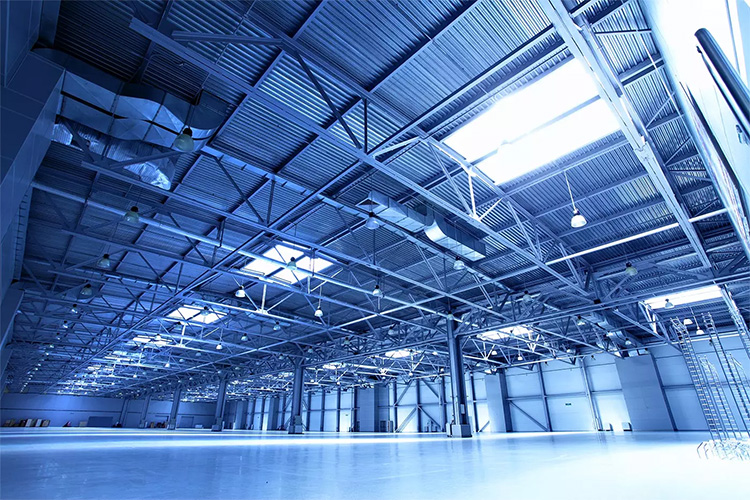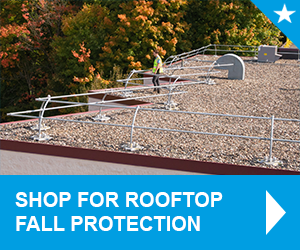Easily Forgotten Industrial Rooftop Fall Hazards: Hatches & Skylights
September 28, 2022
Read the full original article here >
When you look at your industrial facility rooftop, the fall hazard you immediately notice is likely the leading edge. In fact, you probably already have fall protection equipment like guardrails in place at your roof edge to protect workers. However, its important to recognize that other fall hazards exist on your rooftop that require specialized roof safety equipment ranging from a roof hatch safety rail to skylight fall protection cages.
It's imperative that you address the fall protection needs of your employees when their work brings them into contact with the openings on your rooftop. This includes identifying the fall hazards present and installing OSHA-compliant roof safety equipment like guardrail systems, roof hatch and skylight protection, and providing personal fall protection equipment when necessary. And on top of that, you need to provide ongoing safety training for workers to maintain a safe work culture.
OSHA Guidelines for Protecting Roof Openings
In general industry, OSHA requires you to provide fall protection at heights of 4 feet or more above a lower level. Clearly, your building's rooftop is more than 4 feet above the ground, so fall protection being required around the leading edge is obvious. In addition, OSHA 1910.28 says employees must be protected from falling through any hole that is 4 feet (1.2 m) or more above a lower level such as a ladder entrance, skylight, or roof hatch.
Rooftop Skylight Fall Hazards
Skylights are a practical and popular element in large, industrial buildings, letting in natural light to what might otherwise be a windowless interior. Not only does this decrease the need for artificial lighting, thus saving you money, it also has a positive effect on people who work inside the building. As beneficial as they are, however, skylights can be extremely dangerous to workers on your rooftop if proper safety precautions are not taken when working around them.
- Skylights are generally made of glass, plastic, or similar material that is not strong or sturdy.
- If a worker falls onto a skylight, the material breaks and the worker may be injured.
- Skylights cannot handle the weight of materials, tools, and equipment.
- When snow, leaves or other debris accumulates, skylights get buried, making them an invisible danger that can be accidently stepped on.
Skylight Protection Equipment
You're aware that skylights are dangerous and that you need to provide protection for the people accessing your rooftop, but what type of devices and equipment will meet OSHA guidelines? Unfortunately, there is no one-size-fits-all answer to that question. However, there are some ways that you can protect your skylights and remain compliant, including:
- Installing OSHA-compliant skylight fall protection cages over every skylight on the roof.
- Choosing a guardrail system to install around each skylight to limit access.
- Incorporating travel restraint and personal fall arrest systems on sloped roofs or when guardrails and skylight fall protection cages cannot be used.
Rooftop Hatch Fall Hazards
In many cases, employees must access the roof by way of a hatch opening from the inside of the building. While this may be preferable to climbing a fixed ladder on the exterior of the building, it is not without risks. In fact, care must be taken every time a worker accesses a roof hatch. Some common hazards include:
- The ladder that workers must climb inside the hatch poses a potential fall hazard.
- Once a worker exits the hatch, the opening also presents a fall hazard to the workers on the roof.
- In addition, workers still inside the hatch may be at risk of injury from falling objects.
Roof Hatch Protection Equipment
Referring once again to OSHA 1910.28, protecting roof hatches is compulsory. Unlike skylights, when a properly installed roof hatch is closed it does not pose a fall hazard. However, any time an employee must access the roof, they must be protected from the hazards listed above:
- Use a fixed ladder that incorporates a ladder safety system to protect workers when climbing up to or down from a hatch.
- Install grab bars at the hatch opening to assist in transitioning from the ladder to the roof.
- Incorporate a roof hatch safety rail and self-closing safety gate to protect the hatch.
- Provide personal fall protection such as a harness, lanyard, and lifeline when necessary.
Choosing Roof Safety Equipment for Hatch and Skylight Protection
You can't just throw any fall protection solution at a problem and expect it to be successful. The first step in choosing the right roof safety equipment for application is to perform a thorough roof inspection. The presence of a qualified safety expert is highly recommended for this process.
- Inspect roof hatch openings and skylights for obvious fall hazards/lack of safety equipment.
- Note the way workers climb the ladder inside the hatch as well as how they enter and exit the hatch.
- Observe employee use of personal fall arrest equipment and travel restraint systems.
- Ask for recommendations from your safety expert on OSHA-compliant fall protection like different skylight fall protection cages or guardrail systems.
Roof Safety Training
Fall protection really begins at the top with your attitude about safety. Make safety a corporate priority and provide safety training to employees upon hire and at regular intervals during employment. Make sure that all of your workers know how important it is to use fall protection as it's intended to protect them and others. It's also important to have a written safety protocol that workers can refer to when confused about safety issues.
Roof Hatch and Skylight Fall Protection You Can Rely On
Roof hatches and skylights are among the most dangerous fall hazards on an industrial rooftop. Every time an employee enters the roof area, they're at risk of falls and it's up to you to protect them. Per OSHA 1910.28, acceptable means of protecting roof openings include covers, guardrail systems, travel restraint systems, or personal fall arrest systems. If you do not use OSHA-compliant roof safety equipment, you could face severe penalties and fines. And if someone gets hurt, you'll also be held financially responsible.
Concerned about whether your fall protection equipment is adequate on your rooftop? Contact BlueWater today. Our qualified fall safety experts and knowledgeable staff will be happy to answer any fall protection questions you have. We can also assist you with choosing OSHA-compliant fall protection equipment for your industrial facility including a roof hatch safety rail, skylight fall protection, guardrail systems, and industrial safety gates.
@BlueWaterMfg #BlueWaterMfg #skylight #osha #safety
Company:  BlueWater Mfg
BlueWater Mfg
Product: Roof Hatch & Skylight Fall Protection Safety Rails
Source: https://www.tractel.com/bluewater/industrial-rooftop-fall-hazards-hatches-skylights
Tags:
Access Covers
Add direct basement access to any home (fast, economical and convenient) (August 17, 2022), Severe Weather and Extreme Performance Louvers (April 27, 2022), ACDSV acoustical smoke vent designed to guard against noise intrusion while providing the security of automatic smoke venting (February 7, 2022), Window Wells add natural daylight to any underground space (September 13, 2021), Fall Protection Grating for Floor Access Doors (December 7, 2020), 5 Questions With Jim Edgeworth, Residential Sales Director for The BILCO Company (August 31, 2020), Custom Period-Matched Perforated Grilles (June 12, 2020), Automatic Smoke Vents (January 27, 2020), Roof hatches, smoke vents and fall protection (August 28, 2019), Floor access doors for finished flooring (July 30, 2019)
Railing System
Roof
Safety
Skylights
Window Wells add natural daylight to any underground space (September 13, 2021), The Daylighting Difference: Restaurants (June 23, 2021), Design Spotlight: Worship Facilities (May 5, 2021), Sustainable Design: Translucent Panel Daylighting (April 5, 2021), Daylighting Application Spotlight: Transportation Facilities (March 8, 2021), The Daylighting Difference: Designing for Cold Climates (January 6, 2021), The Daylighting Difference: Seasonal Affective Disorder (December 4, 2020), The Daylighting Difference: Energy Efficient Lighting (October 14, 2020), The Best of Both Worlds: Glass & Translucent Panels (August 4, 2020), The Daylighting Difference: Natural Light and Workplace Productivity (May 4, 2020)



